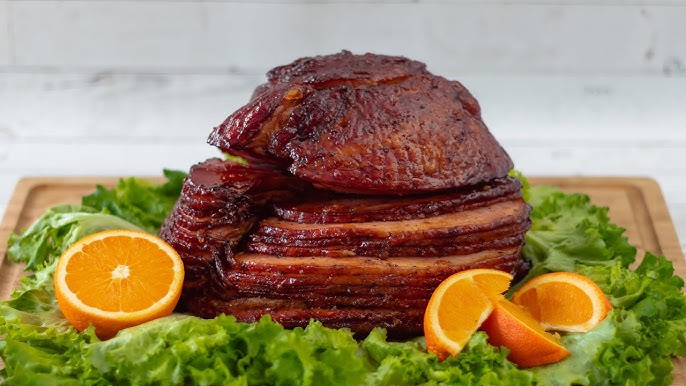Smoked Ham Recipe: There’s just something magical about the rich, smoky aroma of a perfectly smoked ham. Whether it’s for a holiday feast, a weekend BBQ, or just because you’re craving that delicious combo of salt, sweet, and smoke—this recipe has your back. Smoked ham isn’t just tasty; it’s also surprisingly simple once you know the steps.
Let’s walk through how to make a mouthwatering smoked ham from scratch that’ll have everyone begging for seconds.
What is Smoked Ham?
Smoked ham is essentially pork that’s been cured (usually with salt, sugar, and spices) and then cooked using the power of smoke. The process infuses the meat with a savory depth and a beautiful smoky flavor that’s hard to resist. You can buy ham that’s already been smoked, but making it yourself gives you full control over the flavor, texture, and presentation. Plus, it’s a fun cooking project that pays off big time in taste.
Ingredients You’ll Need
Here’s what you need to gather before firing up your smoker:
- 1 whole ham (bone-in or boneless, pre-cooked or fresh)
- Dry rub spices:
- 1/4 cup brown sugar
- 2 tbsp paprika
- 1 tbsp garlic powder
- 1 tbsp onion powder
- 1 tsp black pepper
- 1 tsp cayenne pepper (optional for heat)
- Glaze ingredients:
- 1/2 cup honey or maple syrup
- 1/4 cup Dijon mustard
- 2 tbsp apple cider vinegar
- 1 tbsp soy sauce
- Wood chips (apple, cherry, or hickory preferred)
- Water for the water pan
- Aluminum foil (optional)
These ingredients are simple, but they create layers of flavor. The dry rub delivers bold seasoning on the outside, while the glaze adds that sweet-savory stickiness that makes smoked ham so irresistible.
Types of Ham You Can Smoke
Before we dive into the cooking process, let’s talk about the different kinds of ham you might use. Not all hams are created equal, and your choice will affect both the smoking time and the end result.
Bone-In vs. Boneless
- Bone-in hams have more flavor and tend to stay juicier. They also look more traditional when served.
- Boneless hams are easier to slice and serve, but they can dry out faster if not smoked carefully.
Pre-Cooked vs. Fresh (Green) Ham
- Pre-cooked hams (also called city hams) are already cured and partially cooked. Smoking them adds flavor and finishes the cooking process.
- Fresh hams haven’t been cured. These require longer smoking times and more attention but reward you with deep, authentic flavor.
For beginners, a bone-in, pre-cooked ham is the easiest and most forgiving option. It’s a great starting point if you’re new to smoking meat.
Tools and Equipment Required
You don’t need a fancy smoker setup to make incredible smoked ham, but having the right tools helps. Here’s your checklist:
- Smoker (electric, charcoal, pellet, or wood)
- Meat thermometer (instant-read or digital probe)
- Aluminum drip pan
- Wood chips or pellets
- Tongs and basting brush
- Cutting board and carving knife
Make sure your smoker has enough space to hold the ham comfortably without touching the sides. Temperature control is crucial, so if your smoker doesn’t have a built-in thermometer, get a separate one to monitor the internal and ambient temps accurately.
Choosing the Right Wood for Smoking
The type of wood you use for smoking plays a huge role in how your ham turns out flavor-wise. Some woods impart a strong, bold flavor, while others add a more delicate, fruity note. Here are some popular options:
- Applewood: Mild, sweet, and fruity. Perfect for a subtle smoky flavor that enhances pork.
- Cherrywood: Slightly stronger than apple but still sweet and fruity. Adds a nice mahogany color to the ham.
- Hickory: Bold, bacon-like smoke flavor. Use sparingly or mix with milder woods to avoid overpowering the ham.
- Maple: Light and sweet, giving a well-balanced smoke flavor ideal for glazing.
- Pecan: Offers a nutty, rich flavor without being too overpowering.
For best results, avoid mesquite or oak for ham as they can be too strong. A combination of apple and cherry is a winner for a sweet-smoke balance that complements ham beautifully.
Prepping Your Ham
Before you throw your ham into the smoker, some prep work ensures you get all the flavor and juiciness you’re looking for.
Trimming Excess Fat
While some fat helps with flavor, too much of it can block the smoke from reaching the meat. Trim down any thick outer fat layers, leaving a thin cap to keep things moist during the long smoke.
Scoring the Surface
Take a sharp knife and make shallow crisscross cuts across the surface of the ham. This not only looks good but helps the rub and smoke penetrate deeper. Aim for cuts about 1/4 inch deep and spaced an inch apart.
Brining the Ham (Optional but Recommended)
If you’re using a fresh ham, brining it can make a huge difference. A basic brine includes:
- 1 gallon water
- 1 cup kosher salt
- 1/2 cup brown sugar
- 1 tbsp black pepper
- 2-3 bay leaves
- 1 tbsp crushed garlic
Let the ham soak in the brine for 24 hours in the fridge. It will absorb moisture and seasoning, resulting in a juicier, tastier ham. If you’re using a cured or pre-cooked ham, you can skip this step.
Creating a Flavorful Dry Rub
Your dry rub is the flavor bomb that kicks off the taste journey. It creates a crusty bark on the outside and infuses the meat with seasoning. Here’s a simple but powerful rub recipe:
- 1/4 cup brown sugar
- 2 tbsp smoked paprika
- 1 tbsp garlic powder
- 1 tbsp onion powder
- 1 tsp ground black pepper
- 1 tsp ground mustard
- 1/2 tsp cayenne pepper (optional for heat)
Mix all ingredients in a bowl. Pat your ham dry with paper towels and massage the rub generously all over the surface, getting into the scored cuts. Let it rest for 30-60 minutes at room temp before smoking. This allows the spices to meld into the meat and create that crave-worthy outer crust.
How to Set Up Your Smoker
Whether you’re using a pellet smoker, electric, or charcoal, setting it up correctly is crucial for a successful cook.
Ideal Temperature Range
Keep your smoker steady between 225°F to 250°F (107°C to 121°C). This low and slow approach lets the smoke do its thing without drying out the meat.
Maintaining Consistent Heat
- Fill your water pan to maintain humidity.
- Add wood chips or pellets in small batches to prevent over-smoking.
- Avoid constantly opening the smoker; every peek lets out heat and smoke.
If your smoker has vents, adjust them to control airflow. More air = hotter temps. Less air = lower, slower cooking.
How to Make Smoked Ham – Step-by-Step Guide
Now comes the fun part—smoking the ham!
Step 1: Bring the Ham to Room Temperature
Let your ham sit out for about 1 hour before smoking. This ensures even cooking.
Step 2: Place the Ham in the Smoker
Position the ham cut side down on the grates. Make sure it’s centered so it gets even exposure to the heat and smoke.
Step 3: Monitor the Temperature
For a precooked ham, you’re aiming for an internal temp of 140°F (60°C). For a fresh ham, the target is 160°F (71°C).
Use a meat thermometer to monitor this without opening the smoker too often. Stick the probe into the thickest part, away from the bone.
Step 4: Time Guidelines
As a rule of thumb, smoke for 15-20 minutes per pound for precooked ham and 30-35 minutes per pound for fresh ham.
So, a 10-pound precooked ham will take around 2.5 to 3.5 hours, while a fresh one might need 5 to 6 hours.
Mist the ham every hour with apple juice or cider to keep it moist and enhance flavor.
Making a Glaze for Extra Flavor
This is where things really get tasty. The glaze adds a glossy finish and balances the smoky saltiness with sweet, tangy notes. Here’s a killer glaze recipe you can whip up while the ham is smoking:
Ingredients:
- 1/2 cup honey or maple syrup
- 1/4 cup Dijon mustard
- 2 tablespoons apple cider vinegar
- 2 tablespoons brown sugar
- 1 tablespoon soy sauce
- Optional: pinch of cinnamon or cloves for holiday flair
Instructions:
- Combine all ingredients in a small saucepan.
- Heat on low, stirring until the sugar dissolves and the glaze thickens slightly.
- Let it cool slightly before applying—it should be brushable but not watery.
This glaze caramelizes beautifully on the surface of the ham, creating an irresistible crust. The balance of sweet and tangy really elevates the overall flavor profile.
Glazing the Ham During Smoking
Timing is everything when it comes to glazing. You don’t want to do it too early or the sugars will burn and turn bitter. Here’s how to get it just right:
When to Glaze:
- Start glazing when your ham is about 30-45 minutes away from being done.
- That’s usually when the internal temp is around 120°F for precooked ham or 145°F for fresh ham.
How to Apply:
- Use a silicone basting brush and coat the entire surface generously.
- Close the smoker lid and let it cook for 10-15 minutes.
- Repeat the process two or three times for a rich, sticky glaze layer.
If you want that glossy magazine-cover finish, you can even give the ham a final glaze and pop it under a broiler for 5 minutes right before serving—just be careful not to burn it.
How to Know When the Ham is Done
Don’t just go by time—internal temperature is the gold standard here. Use a reliable digital meat thermometer to ensure your ham is safe and juicy.
Target Temperatures:
- Precooked Ham: 140°F (60°C)
- Fresh Ham: 160°F (71°C)
Where to Check:
Insert the thermometer into the thickest part of the ham without touching the bone. The bone can retain heat and give a false reading.
Pro Tip:
If you’re using a bone-in ham and see juices starting to bubble up and the meat pulling back from the bone slightly, you’re right on track.
Once it hits the target temp, remove the ham immediately and move to the next step—resting.
Resting and Carving the Ham
Resting the ham is crucial. Just like with any big cut of meat, this lets the juices redistribute and settle, making each bite tender and flavorful.
Resting Time:
- Let the ham rest for 15-20 minutes before carving.
- Tent it loosely with foil to keep it warm without steaming the crust.
Carving Tips:
- For bone-in hams, slice around the bone and cut perpendicular to it.
- For boneless hams, just slice to your desired thickness.
Use a sharp carving knife for clean cuts, and don’t forget to taste a slice right off the board—you’ve earned it!
Serving Suggestions and Storage Tips
Your smoked ham is now the star of the table, but the party doesn’t end there. Here’s how to serve and store it like a pro.
Serving Ideas:
- Pair with classic sides like scalloped potatoes, roasted Brussels sprouts, or mac and cheese.
- Slice leftovers for sandwiches with mustard and pickles.
- Dice it into omelets, fried rice, or soups for smoky flavor boosts.
Storage:
- Refrigerate in an airtight container for up to 5 days.
- Freeze leftovers for up to 2 months—wrap tightly in foil, then a freezer bag.
To reheat, wrap slices in foil and warm in a 300°F oven until hot, or use a skillet for crispy edges.
FAQs about Smoked Ham Recipe
What type of wood should I use for smoking ham?
When smoking ham, the type of wood you choose can significantly influence the flavor. Fruit woods like apple and cherry offer a milder, sweeter taste, ideal for enhancing the ham’s natural flavors without overpowering them. Hickory and maple are also popular choices, providing a more robust smoky flavor.
How long does it take to smoke a ham?
The smoking time for a ham depends on its size and the temperature of your smoker. Generally, you should plan for about 15-20 minutes per pound at a smoking temperature of around 225°F (107°C). For a 10-pound ham, expect the smoking process to take approximately 2.5 to 3.5 hours. Always use a meat thermometer to ensure the internal temperature reaches 140°F (60°C) for a fully cooked ham.
Do I need to brine the ham before smoking?
Brining the ham isn’t strictly necessary if you start with a pre-cured or pre-cooked ham, but it can enhance juiciness and flavor. For a fresh ham, brining is highly recommended to add moisture and taste. A simple brine can be made with water, salt, sugar, and spices, and the ham should be submerged in the brine for 24 to 48 hours before smoking.
Can I smoke a pre-cooked ham?
Absolutely! Smoking a pre-cooked ham is a great way to impart additional smoky flavor. Since the ham is already cooked, you’re essentially reheating it and adding flavor. Keep the smoker temperature low, around 225°F, and smoke until the internal temperature of the ham reaches 140°F. This usually takes about 10 minutes per pound.
What are the best glazes for smoked ham?
Glazes can add a sweet or savory finish to your smoked ham. Popular options include a honey mustard glaze, brown sugar and pineapple glaze, or a maple syrup and bourbon mixture. Apply the glaze during the last 30-45 minutes of smoking to allow it to caramelize nicely without burning.
Should I cover the ham while smoking?
Covering the ham is not necessary during the smoking process, as you want the smoke to circulate freely around the meat. However, if you notice the outside of the ham getting too dark, you can tent it loosely with aluminum foil to prevent excessive browning.
How do I store leftover smoked ham?
Leftover smoked ham can be stored in the refrigerator for up to 5 days. Make sure it’s wrapped tightly in plastic wrap or aluminum foil, or store it in an airtight container. For longer preservation, you can freeze the smoked ham for up to 3 months. When ready to enjoy, thaw in the refrigerator before reheating.
Conclusion
There’s nothing quite like the satisfaction of crafting a perfectly smoked ham from scratch. It’s rich, smoky, juicy, and versatile—plus, it’s a dish that brings people together, whether it’s a holiday feast or a backyard get-together. With just a little time, the right wood, and a good glaze, you can turn a humble cut of pork into a show-stopping centerpiece.
So go ahead—grab that smoker, fire it up, and get to work. Once you taste the smoky-sweet results, you’ll be hooked for life.



